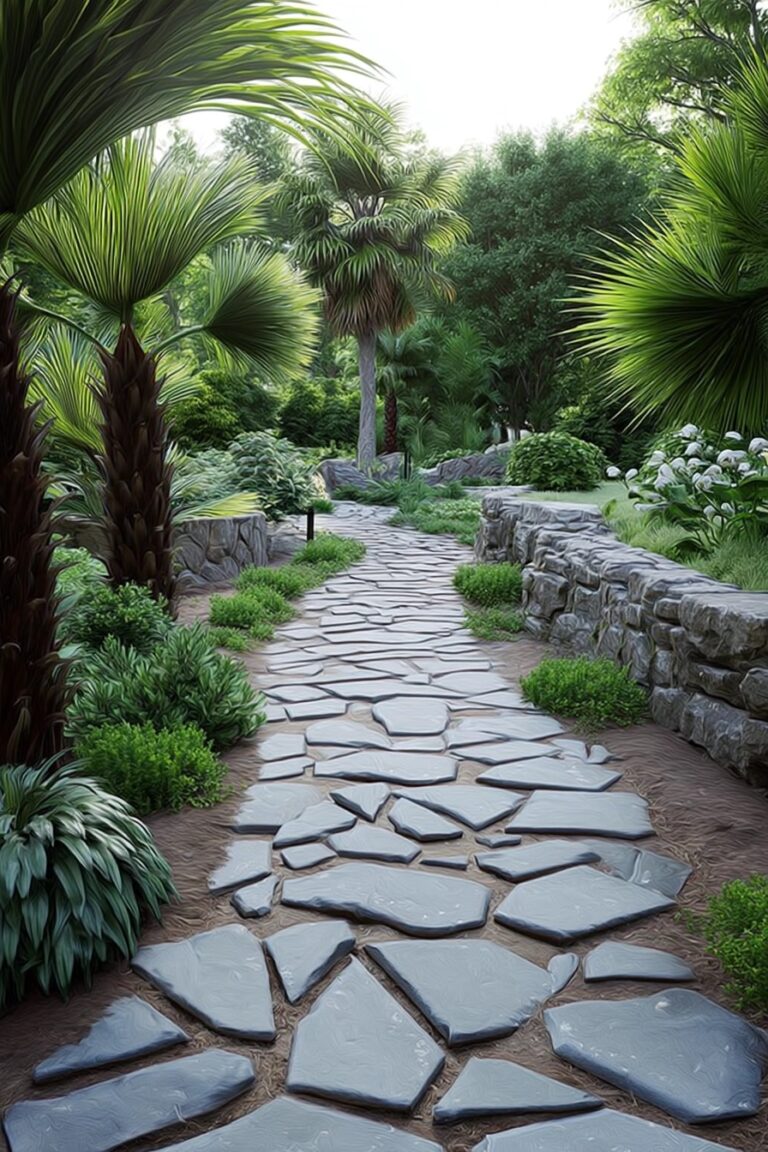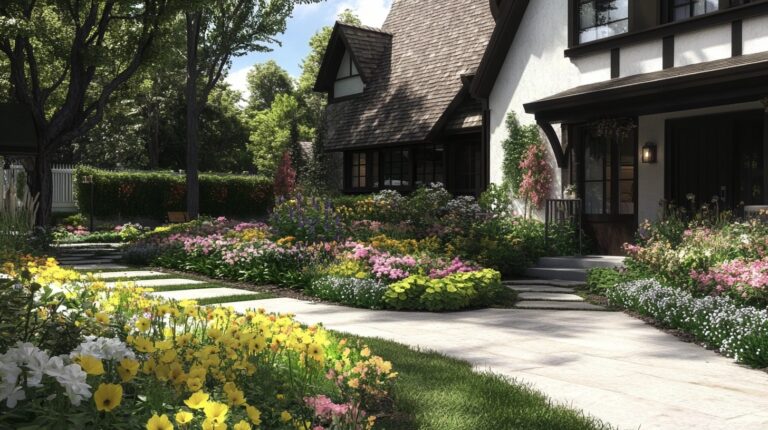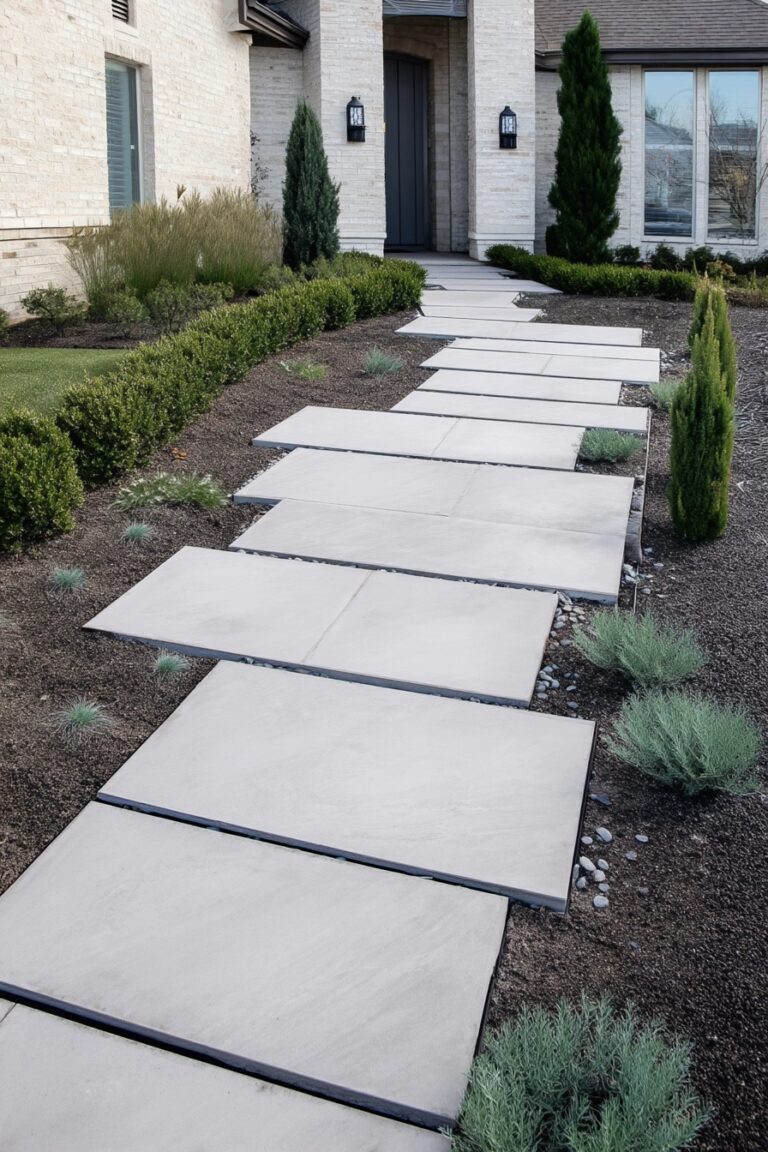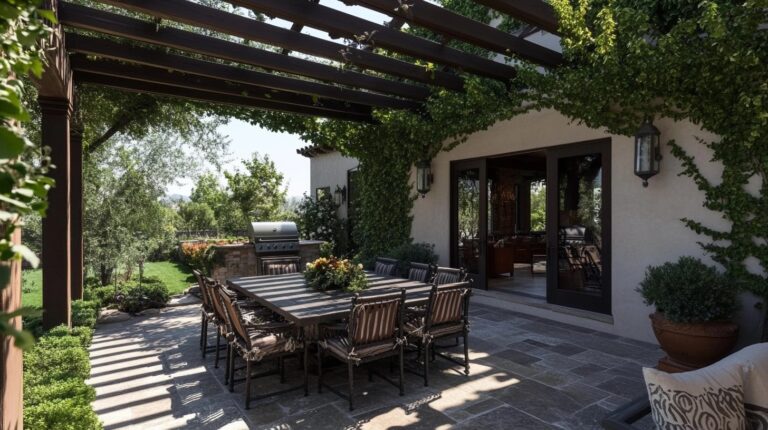Stepping into your garden should feel like an adventure, right? A well-trodden patch of grass just doesn’t quite cut it! Whether you’re dreaming of a charming cobblestone look or need a super simple, budget-friendly walkway, creating a proper garden path can totally transform your outdoor space. Let’s wander through some inspiring garden path ideas together – you might be surprised how easy and affordable your dream path can be!
16 Breathtaking Garden Path Ideas To Instantly Elevate Your Yard (Even on a Budget!)
1. Walk on the Wild Side: Mossy Flagstone Magic
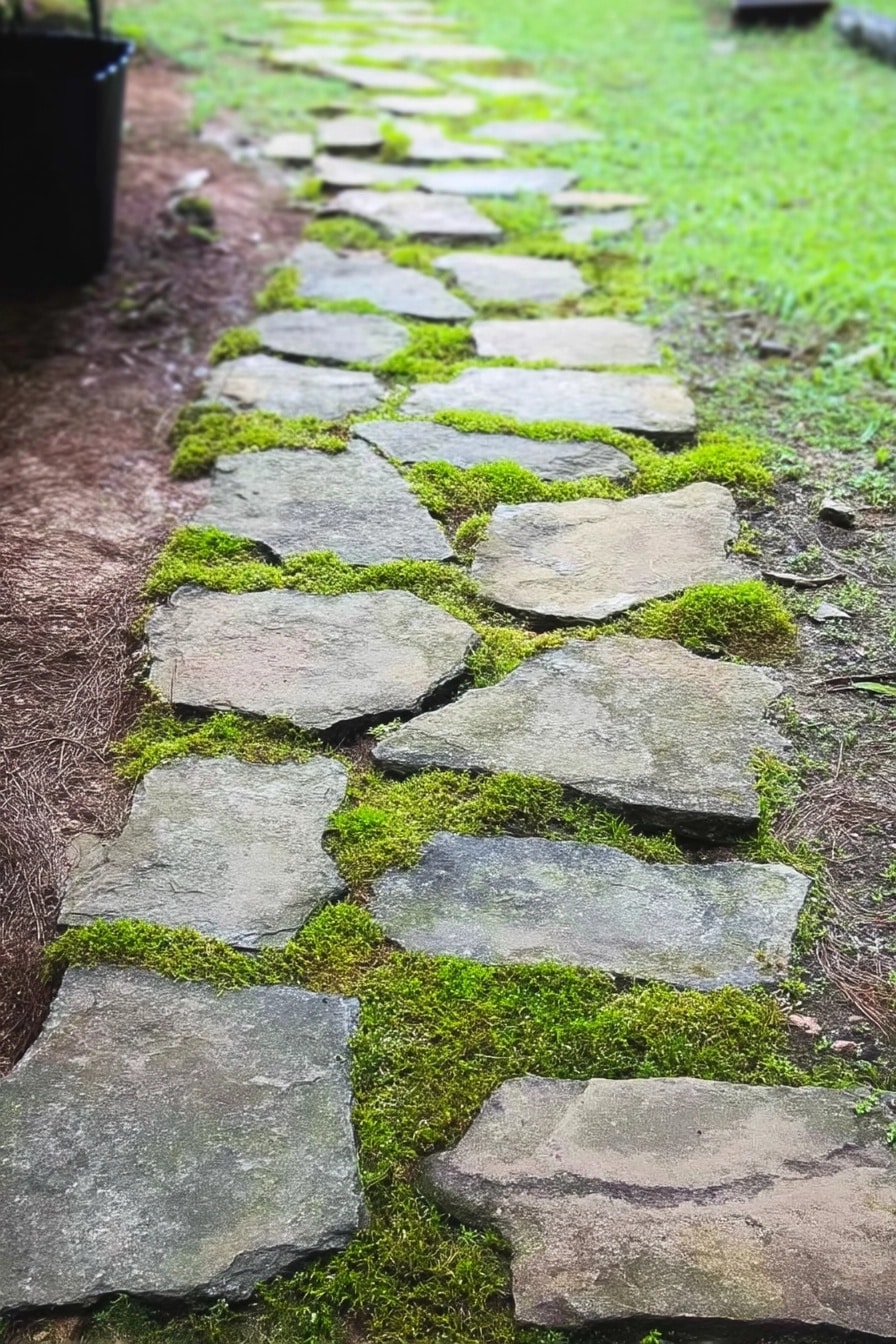
Love a path that looks like it sprang up naturally? Then natural flagstones might be your jam. These irregular stones give an instant “old garden” vibe, especially when you let moss grow between them.
Seriously, don’t weed the moss! I actually encourage it. Some people think it’s messy, but I think it adds tons of character and makes the path look ancient, even if it’s new. It feels like a fairy path!
- Pros: Looks super natural, very durable stones, totally unique result.
- Cons: Can be uneven underfoot, stones are heavy work, moss gets slippery when wet (be careful!).
Make sure the tops of the stones are mostly flat so you don’t trip. A little wiggle is fine, but you don’t want an ankle-breaker. Use a rubber mallet (a hammer with a rubber head) to tap them firmly into the dirt.
2. Skinny Space Savvy: Chic Narrow Gravel & Paver Path
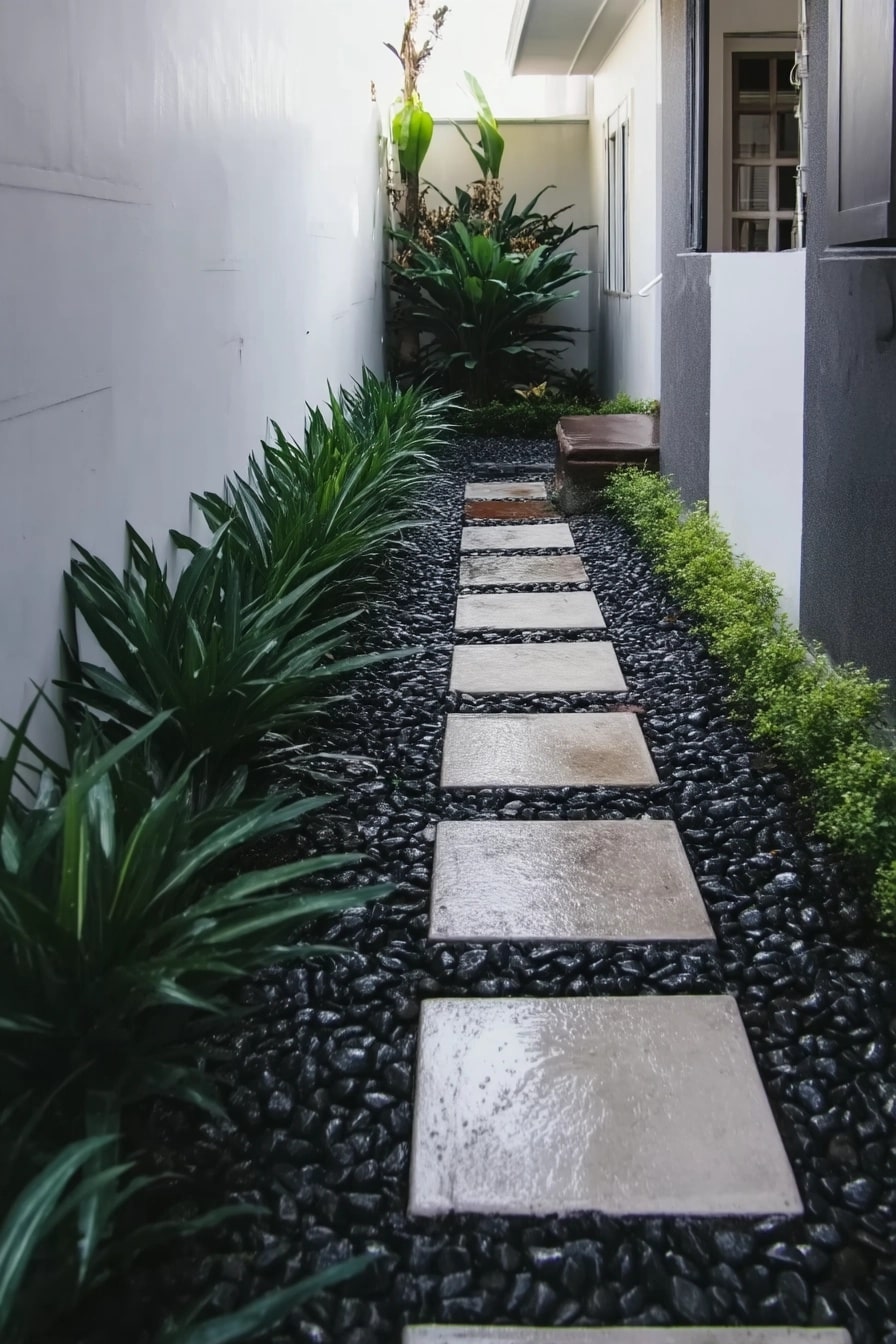
Got that awkward narrow space down the side of the house? Don’t ignore it, make it awesome! This look uses sleek square stepping stones (pavers) set in dark gravel for a modern and clean path.
The mix of smooth stone and crunchy gravel looks cool and feels nice to walk on. Bonus: gravel helps water drain away, which is often a problem in those tight side yards.
My controversial take? You absolutely NEED landscape fabric under the gravel. It’s a pain to put down, I know. But trust me, weeding gravel pathways is the WORST garden job ever. I skipped it once… never again!
3. Small Yard, Big Style: Bright Gravel & Stepper Combo
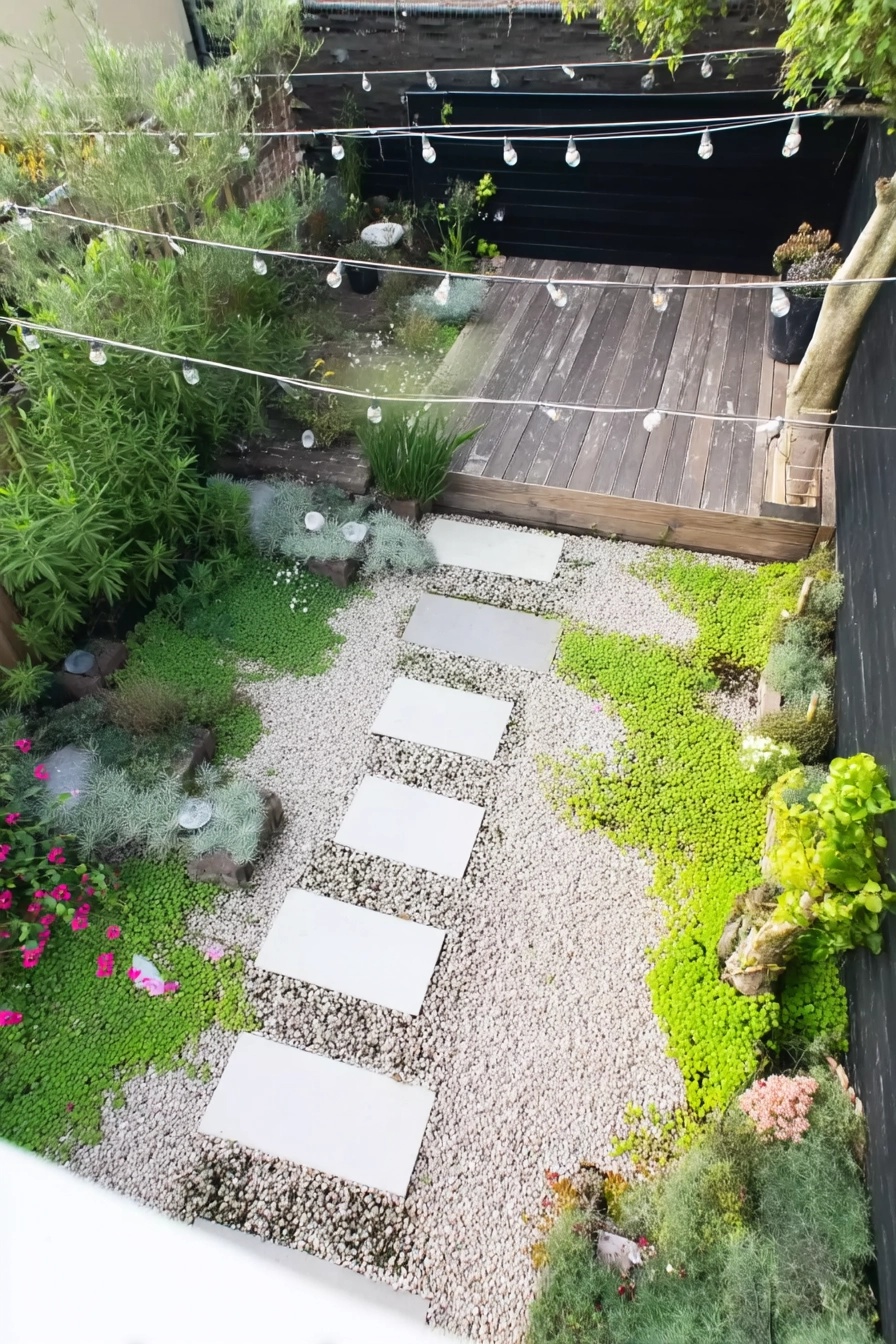
Who says small gardens can’t have cool paths? Not me! Using light-colored gravel, like this pea gravel, makes a tiny space feel way bigger and brighter.
Adding simple, rectangular stepping stones keeps it from looking too busy. It leads your eye (and feet!) nicely without taking over the whole yard. Perfect for getting to a little bench or through flowers.
- Tool Time: A wheelbarrow is essential for moving gravel, even small amounts. Save your back!
- Keep it Tidy: Use some kind of edging (metal strips, rocks, wood) to stop the gravel from escaping into your plants or lawn.
This is a seriously affordable garden path idea that looks way more expensive than it often is. Big style points on a small budget!
4. Step into Art: DIY Mosaic Garden Stones

Want a path that screams “YOU”? Get your craft on with DIY mosaic stepping stones! This is your chance to go wild with creativity. Use broken plates, old tiles, pretty glass bits – whatever you find.
It’s a super fun weekend project. My first attempt involved leftover bathroom tiles and some pebbles – it wasn’t perfect, but making it was a blast! You can buy stepping stone kits or just use old plastic containers as molds for concrete.
Important Bit: Make sure no sharp edges are sticking up from your mosaic! Push everything firmly into the wet concrete. Use grout made for outdoors and seal it well so your art lasts.
5. Simple & Sweet: Easy Pavers with Mulch Edging
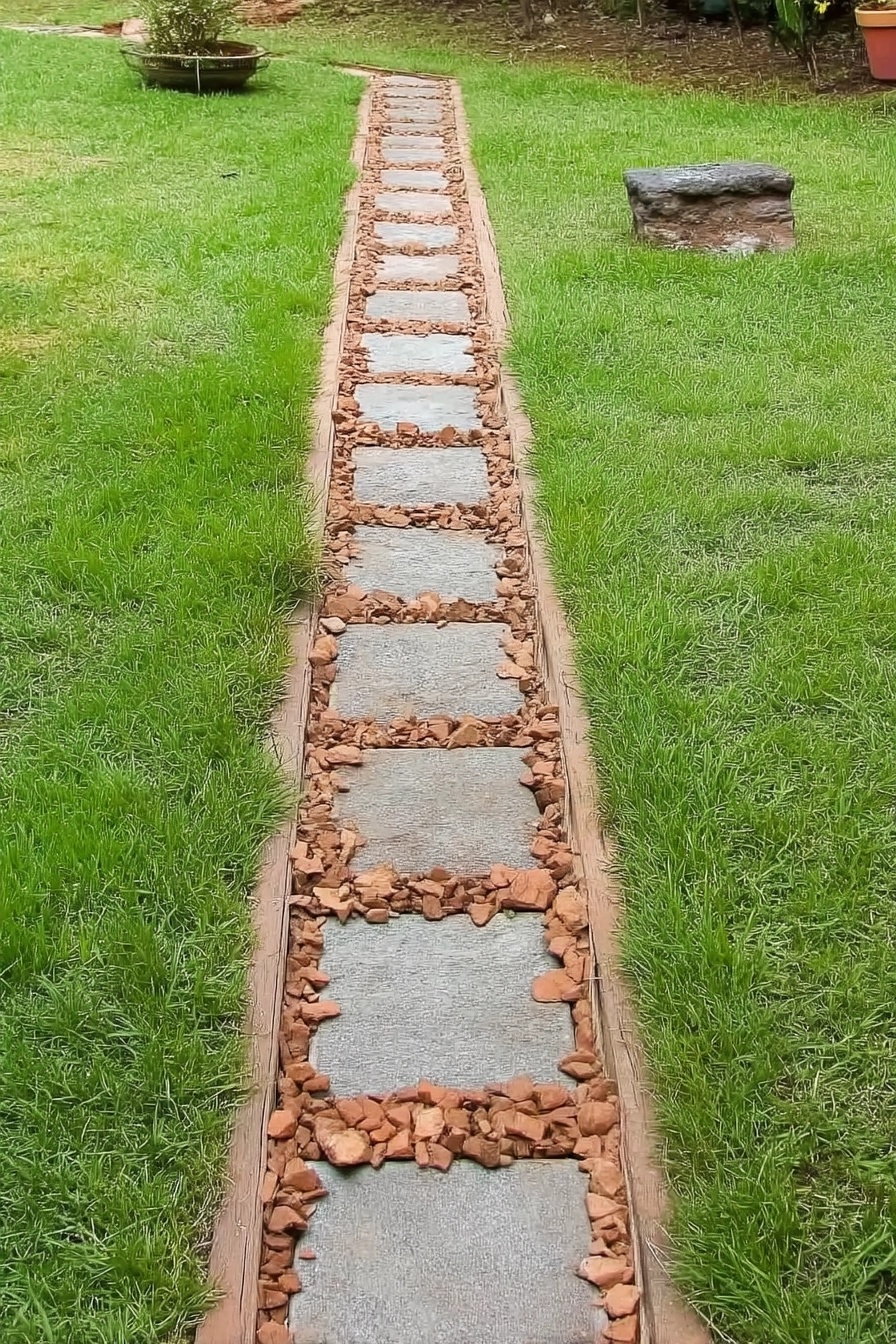
Need a path… like, right now? This is probably the simplest, easiest DIY garden path. Just grab some basic square concrete pavers, lay them in a line, and fill the gaps with cheap mulch.
It’s not fancy, but it works! It defines the path, keeps your feet out of the mud, and looks much tidier than a worn-down track in the grass. You can just set them on level dirt.
This is also a fantastic rental-friendly garden path idea. Nothing is permanently stuck down. You can pick up the pavers and rake away the mulch when you move. Easy peasy!
6. Modern Lines: Sleek Concrete Slabs Meet Gravel
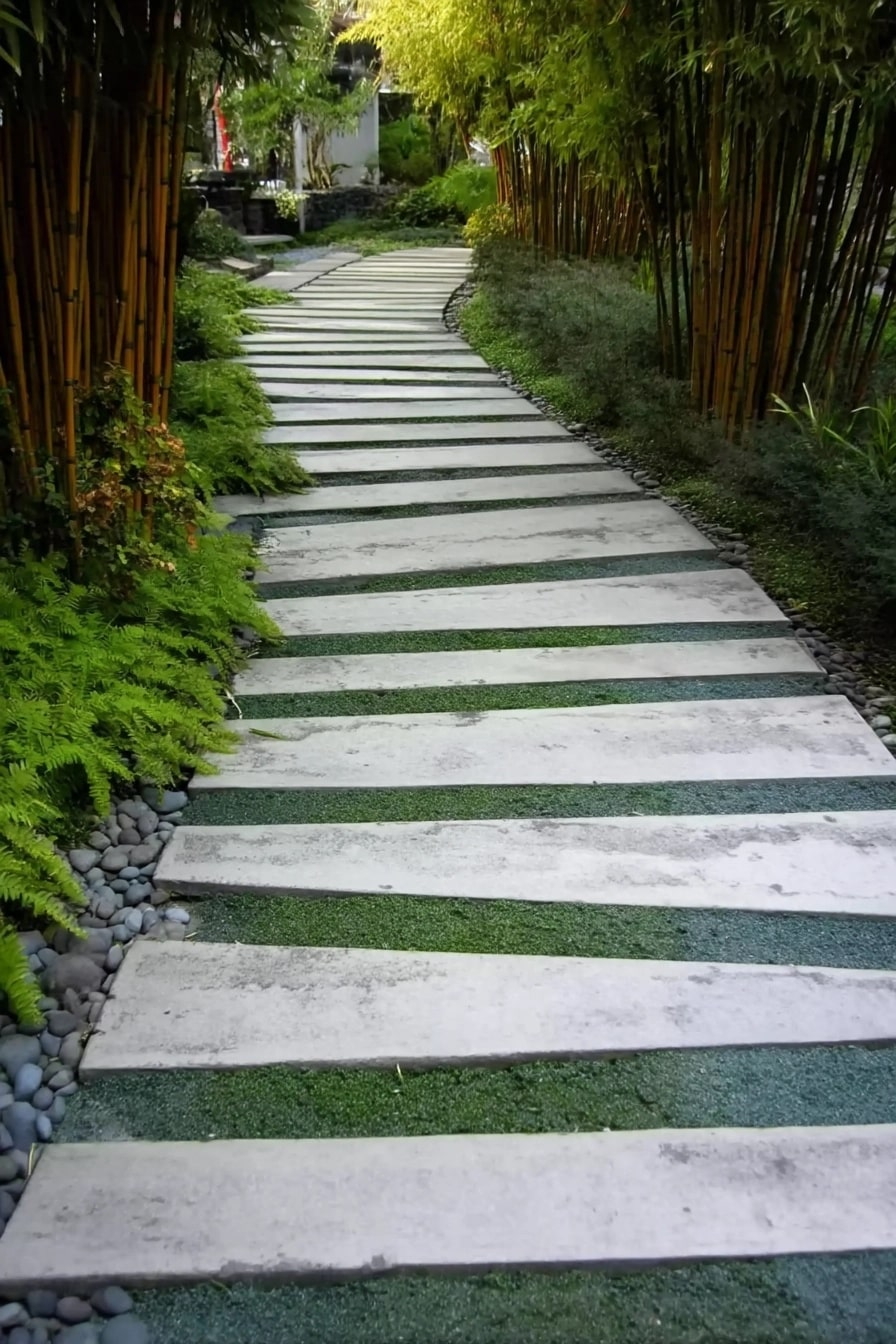
If your house is more modern, match it with a path like this. Long, skinny concrete slabs create cool lines. Setting them in contrasting gravel or tiny pebbles makes the shapes pop.
I love how this looks both super planned and kinda natural, especially next to soft plants like ferns. It gives off a calm, zen garden vibe. Very chic!
- Pro Tip: Getting these big slabs perfectly flat and even takes time. Use a level tool (the longer the tool, the better the result!) and don’t rush.
- Filler Fun: The stuff between the slabs matters. Fine gravel, smooth pebbles, or even tough little plants like mondo grass work great.
It takes a bit more effort to get this sleek garden path right, but wow, does it look sharp when it’s done!
7. Go Formal: Crisp Concrete Pavers & Green Grout

Want a garden that looks neat, tidy, and maybe a bit fancy? A grid of big square pavers creates that formal garden path feel. It looks very planned and orderly.
The coolest part here is planting tiny groundcover plants in the gaps instead of sand. Things like creeping thyme or Irish moss make a ‘green grout’ that softens the concrete.
Reality Check: This look needs more upkeep than gravel. You need good soil between the pavers, the right plants for your sun/shade, and you’ll have to trim them sometimes. But it’s gorgeous!
8. Classic Curb Appeal: Tidy Paver Walkway Style
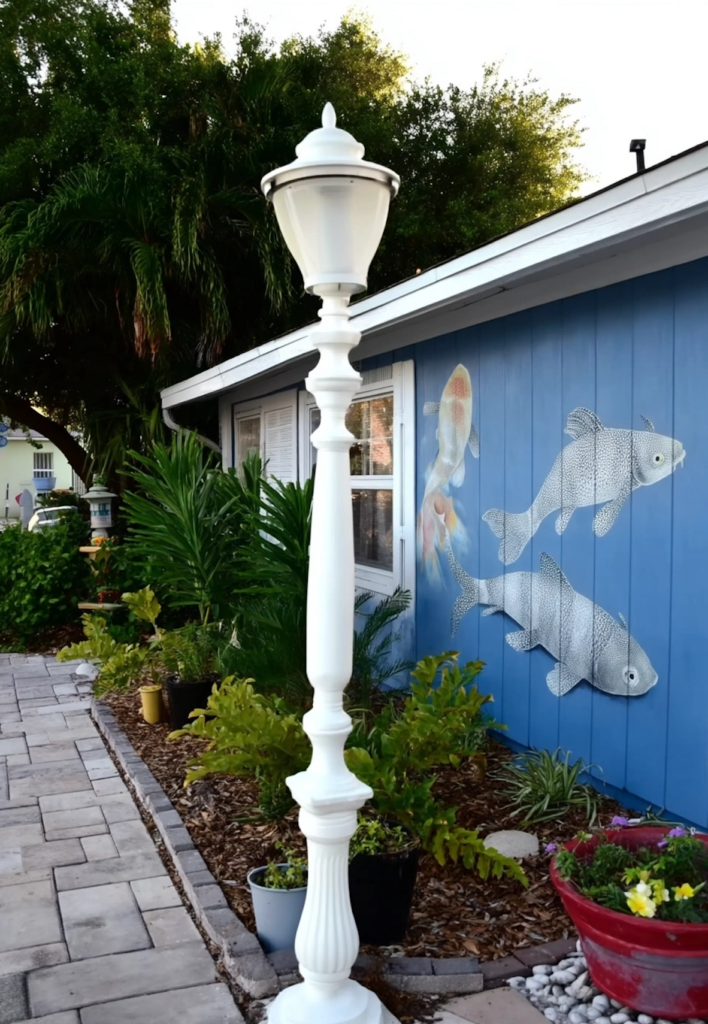
Sometimes you just need a solid, good-looking path that gets the job done. Interlocking pavers (the kind that fit together like puzzle pieces) are super popular for a reason: they’re tough and look neat.
This path is practical for getting from the driveway to the door, looks tidy next to the mulch beds, and boosts the home’s curb appeal. The lamppost is a nice touch!
My honest opinion? While you can DIY interlocking pavers, getting them perfectly flat and locked requires serious ground prep (digging, adding layers of gravel and sand, tamping it down hard). For a pro finish, consider hiring someone.
9. Follow the Flowers: Winding Natural Stone Path

Doesn’t a curvy path just make you want to see what’s around the corner? A winding path using natural stones feels much more relaxed and whimsical than a straight one.
It encourages you to slow down and actually *look* at the garden. Letting plants like these marigolds spill over the edges adds to the casual, cottagey feel. Just make sure the stones are big enough to step on comfortably.
My Fail Story: First time I made a path like this, I just plopped the stones on the dirt. They wobbled like crazy! You gotta dig a shallow hole for each stone and put a little sand underneath to make it stable. Lesson learned!
10. Super Cheap & Easy DIY: The Humble Pallet Wood Path
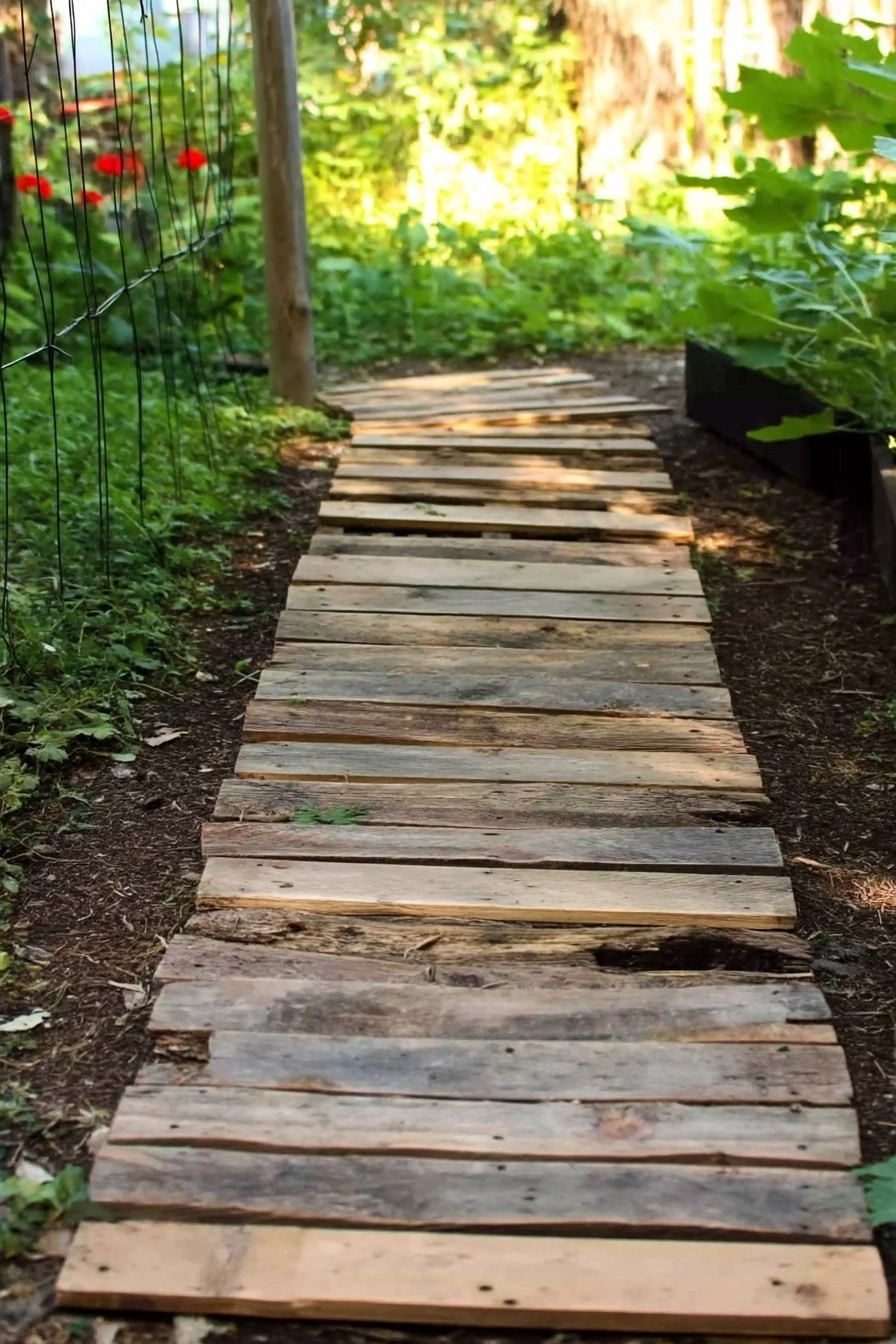
Need a path for basically $0? Hello, pallet wood! Businesses often give away old wooden pallets for free (just ask nicely!). It’s a fantastic source for free garden path ideas.
Take the pallets apart (a saw that cuts through nails helps A LOT) and just lay the planks down. Instant rustic path! Perfect for keeping your shoes clean in the veggie patch or a woodsy area.
- Pros: Dirt cheap (or free!), super easy, looks rustic cool.
- Cons: Wood rots eventually (especially pine), can get slippery/splintery, watch out for leftover nails.
Some people hate how rough it looks, but I kinda dig the weathered vibe. Just know it won’t last forever, maybe only a few years in wet weather unless you seal it (which adds cost).
11. Budget-Friendly Beauty: Gravel & Paver Path on a Dime
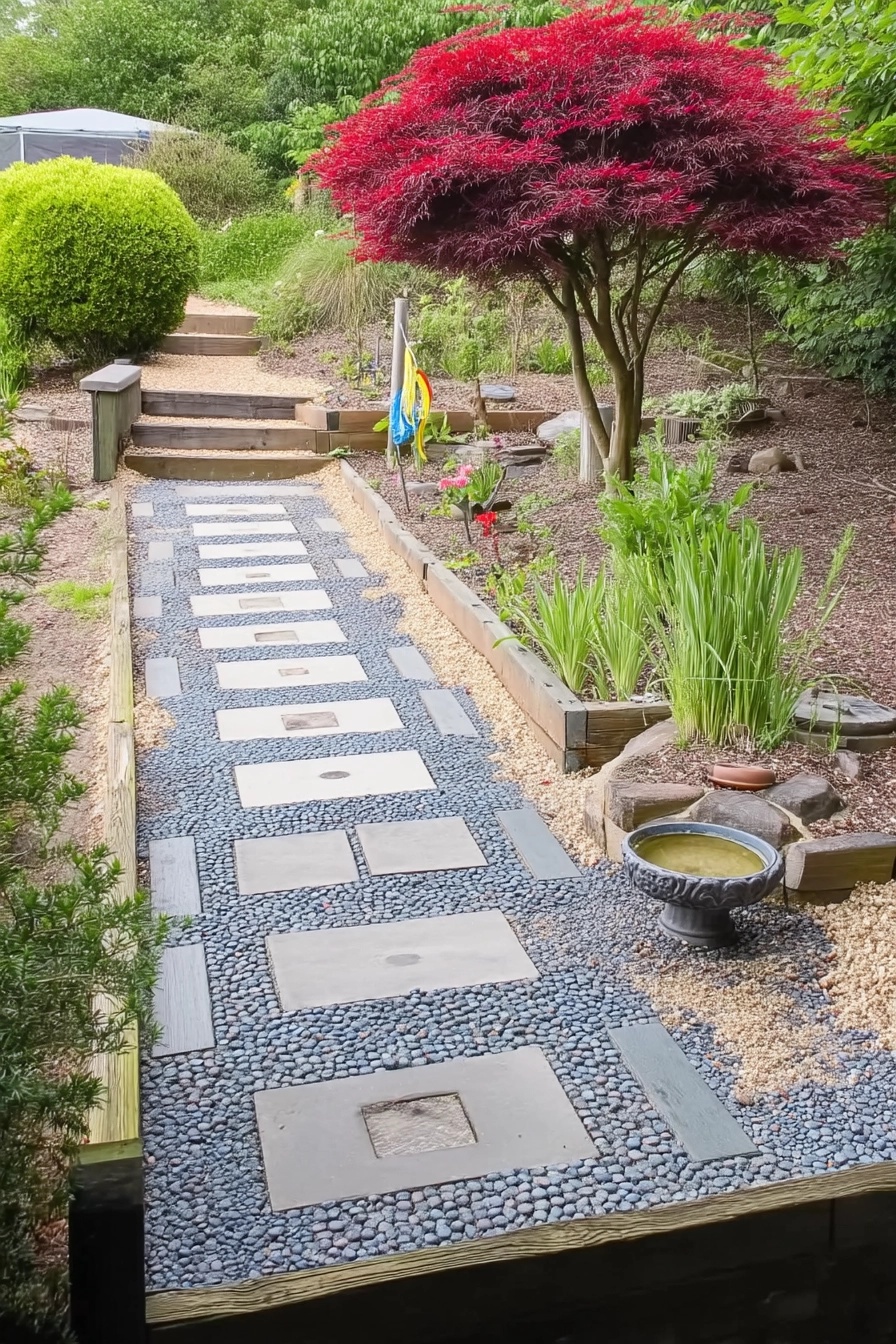
Here’s another winner for a garden path on a budget. Mix cheap pea gravel with simple concrete stepping stones. You get solid spots to walk, plus the nice texture of gravel, without spending a fortune.
See the wood edges? That’s key! Edging keeps the gravel contained so it doesn’t spill everywhere and look messy. Simple treated wood boards work great and aren’t expensive.
This combo is awesome because it works for straight paths, curvy paths, big yards, tiny yards… it’s super flexible and gives you a lot of bang for your buck. A real workhorse inexpensive garden path idea.
12. Let it Grow: Flagstones Nestled in Living Groundcover
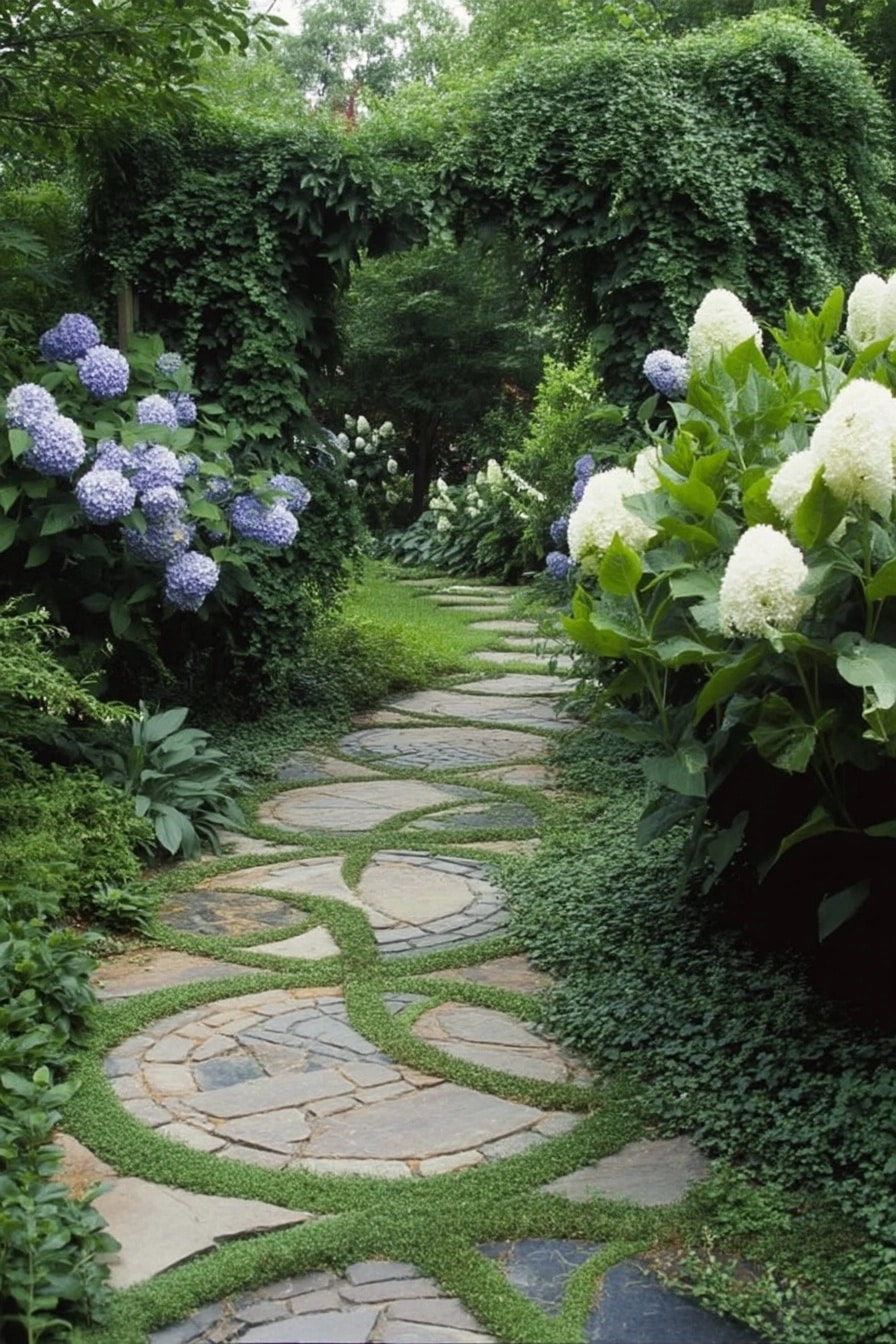
Remember the mossy path? This is like its fancy cousin! Big flagstones are set further apart, letting tough little groundcover plants fill in the gaps like a green, living carpet.
It looks absolutely magical, like something out of a storybook. This works best where people don’t walk constantly, as the plants need space to spread. Choose plants that can handle some foot traffic.
Good Plant Choices: Creeping Thyme (smells great!), Blue Star Creeper, Corsican Mint, tough Sedums. Make sure you pick something right for your sun/shade conditions! A little research goes a long way here.
13. Old School Cool: Timeless Herringbone Brick Walkway
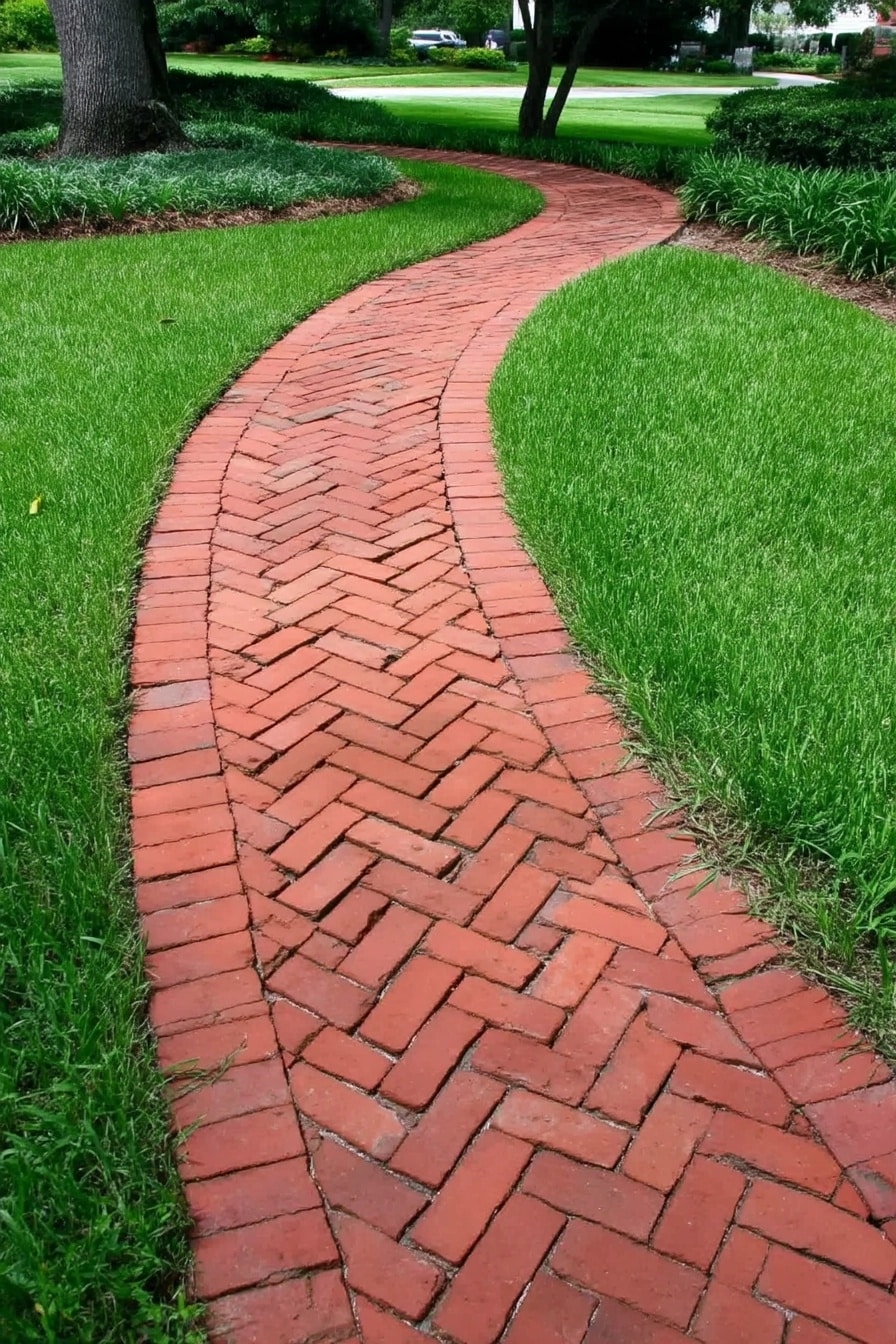
You just can’t go wrong with brick. It’s classic, sturdy, and looks great basically forever. Laying bricks in a pattern like this herringbone zig-zag adds extra style points.
Okay, real talk: laying brick properly is hard work. You need a solid base underneath (packed gravel and sand) and getting the herringbone angles perfect takes patience. My arms were sore for days after my first brick project!
- DIY Sweat Equity: This is a workout! Renting a “plate compactor” machine to pack the base down is totally worth it.
- Brick Choice: Use “paver” bricks meant for walkways, not just regular wall bricks. They’re stronger.
It might cost more upfront than gravel, but a well-done brick path lasts ages, making it a good long-term garden path idea.
14. Secret Garden Vibes: Charming Winding Brick Paths
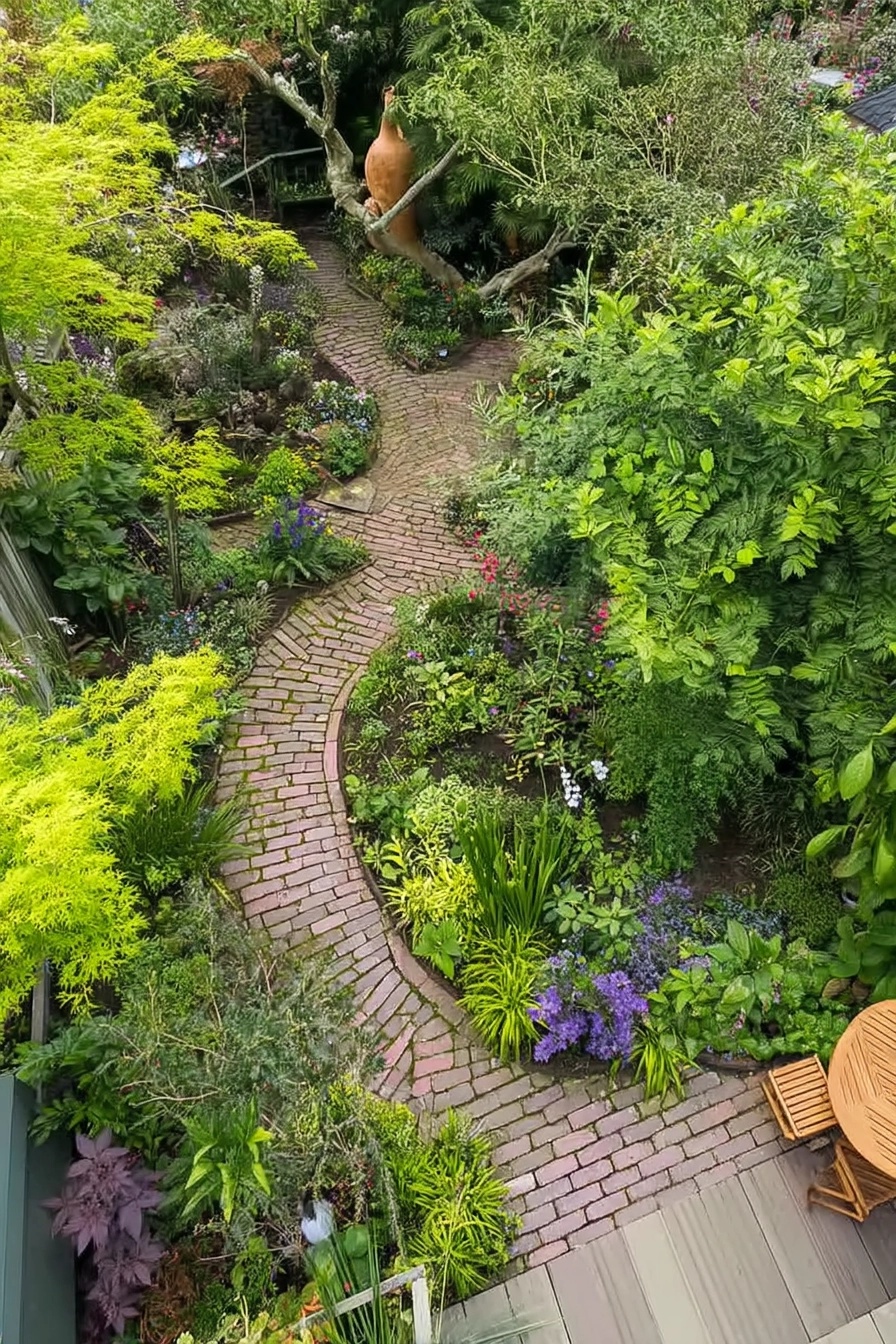
Mix classic brick with gentle curves, and boom – instant Secret Garden! A winding path makes a garden feel mysterious and invites you to explore what’s hidden around the corner.
This style looks amazing in gardens with lots of plants, like cottage gardens. Letting flowers and leaves hang over the edges makes the path feel like part of the garden itself.
Making smooth curves with rectangle bricks means you’ll probably have to cut some. A special saw for cutting bricks (a wet saw) makes this way easier, but you might need to rent one. Or just embrace slightly chunkier curves!
15. Rustic Charm: Aged Bricks for Cottage Style
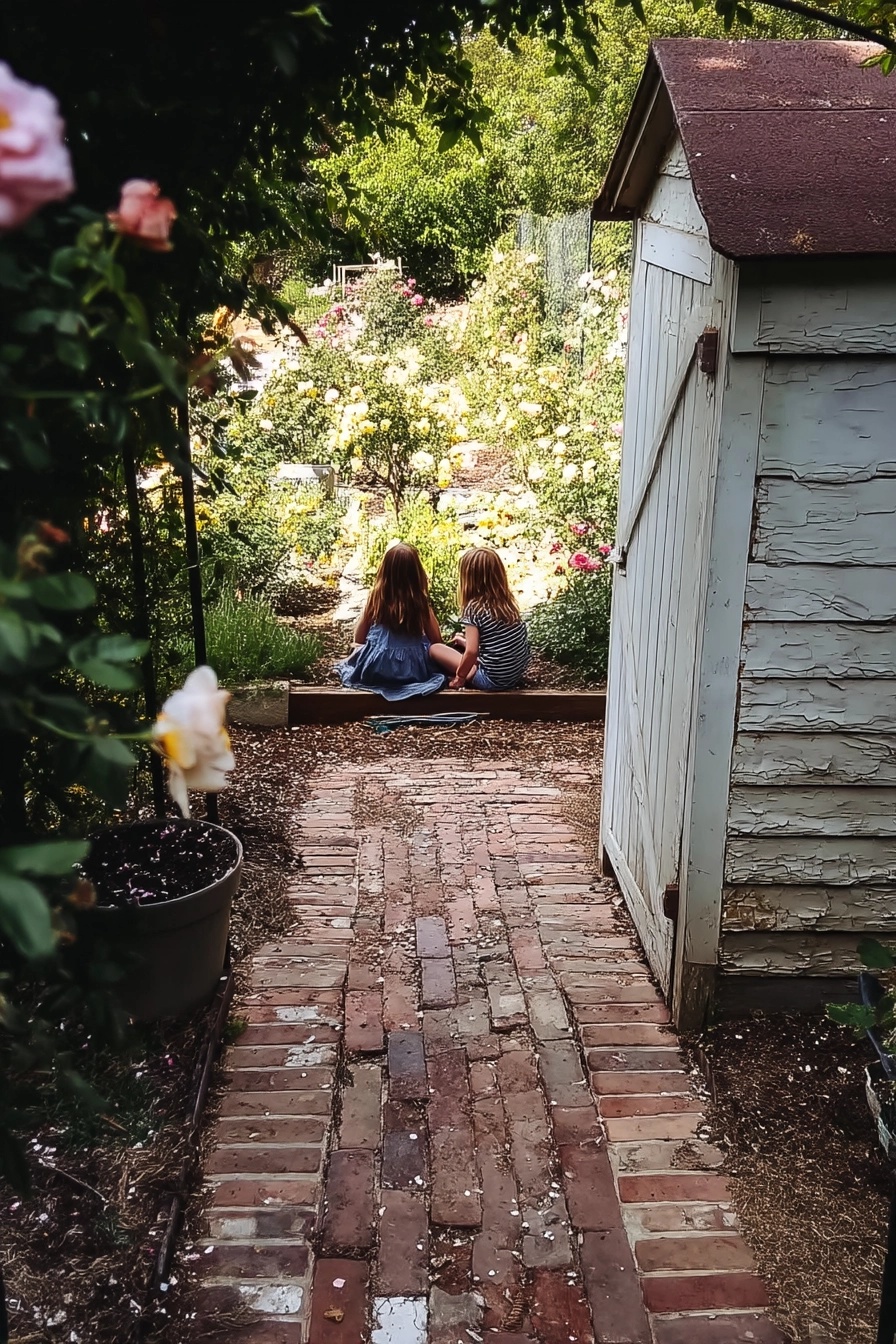
Want that cozy, I’ve-lived-here-forever look? Hunt down some old, used bricks. Chips, color changes, bits of moss – those “flaws” are what give them amazing rustic character.
The path doesn’t need to be perfectly flat either. A little unevenness adds to the charm (just not so bumpy it’s dangerous!). You can often just lay these on a bed of sand for an easy DIY approach.
Finding used bricks can be an adventure! Check places that sell salvaged building materials or look online. Sometimes you can find them cheap or even free, making this an affordable garden path idea if you get lucky!
16. Texture Time: Mixed Pebble & Stone Riverbed Path
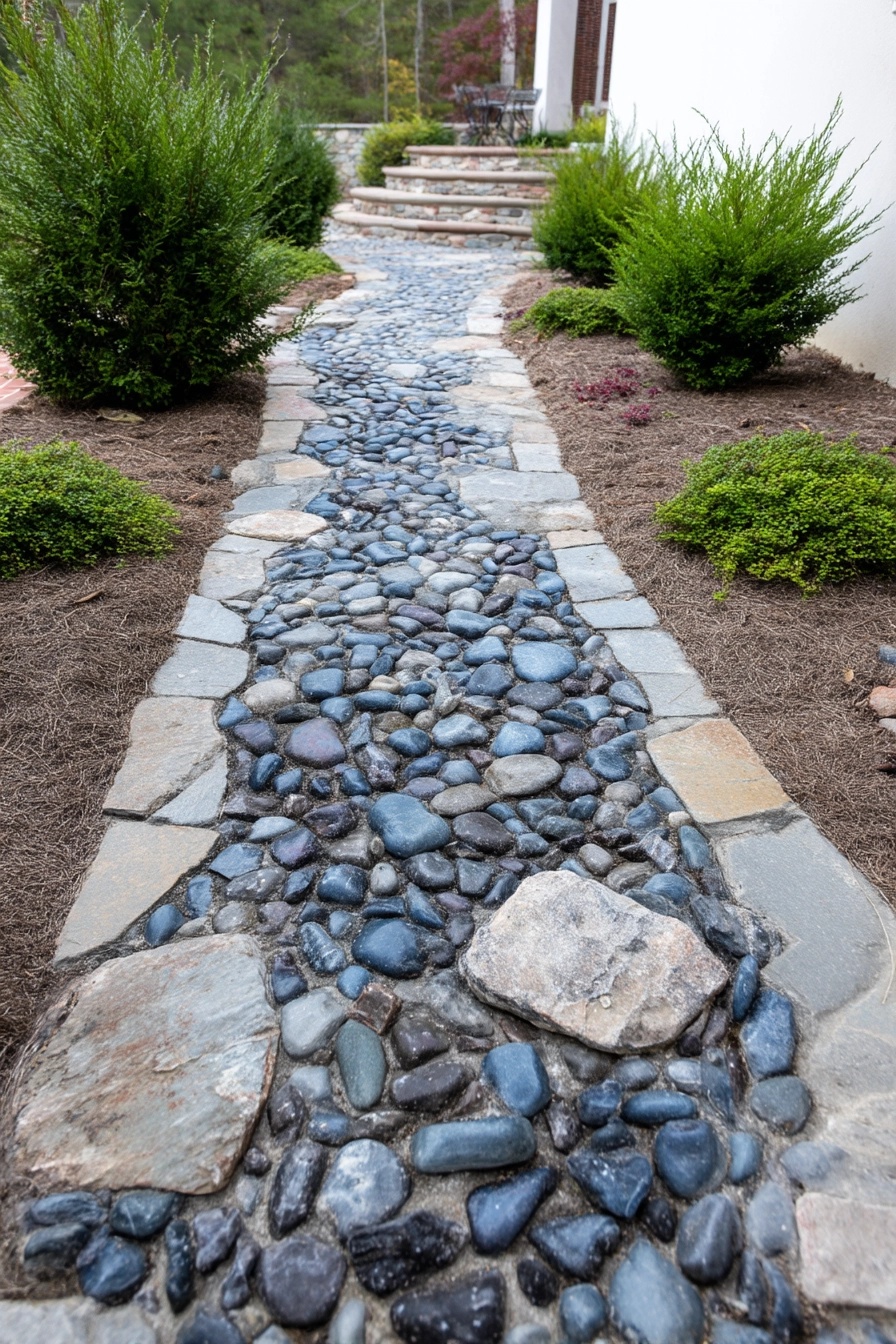
Okay, how cool and unique is this? It looks like a dry stream bed, using smooth river pebbles down the middle and bigger flat stones on the sides. It’s all about mixing textures!
This adds so much visual interest, especially if you like a natural or maybe Japanese garden style. It can even help guide rainwater if you plan it right, acting like a functional swale.
Play Around: Use different colored pebbles, mix in some larger rocks. Just make sure the side stones are flat and stable enough to walk on easily if this is a main path. You might need to set them firmly in packed gravel or even a little concrete footing.
FAQ
Q: What is the cheapest way to make a garden path?
A: The most inexpensive garden paths often use materials like wood chip mulch, pea gravel, or simple stepping stones spaced directly on the lawn. You can sometimes source free mulch from local tree services or use reclaimed materials like old bricks or wood slices for a truly budget-friendly option.
Q: What are some easy DIY garden path ideas?
A: Mulch or gravel paths are very beginner-friendly; simply clear the area, lay landscape fabric (optional but recommended), and spread your chosen material. Placing pre-made stepping stones or concrete pavers directly onto levelled soil or grass is another straightforward DIY project requiring minimal tools and expertise.
Q: How can I make a simple path in my garden?
A: For ultimate simplicity, define a path using natural edging like stones or small logs, and then cover the walkway with an easy-to-spread material like bark mulch or pea gravel. Another simple idea is strategically placing flat stones or basic concrete pavers to create stepping stones across a lawn or through a garden bed.


